An Improved Human-Inspired Algorithm for Distribution Network Stochastic Reconfiguration Using a Multi-Objective Intelligent Framework and Unscented Transformation
Abstract
:1. Introduction
1.1. Motivation
1.2. Literature Review and Research Gap
- The review of the literature has shown that the operation of the distribution network is based on the optimization of the network configuration with various goals, including the minimization of losses and voltage deviations, as well as the improvement of reliability and power quality in various studies, but the investigation of these goals is scattered and single- or double-objective. Moreover, it has not been evaluated as a comprehensive objective function;
- From the evaluation of the literature, it is clear that the lack of a multi-objective optimization structure consisting of various objectives of minimizing power losses, improving reliability indicators, and also improving distribution network power quality indicators in solving the reconfiguration problem to achieve the optimal network configuration by creating a compromise between different goals is felt;
- In previous studies, the reconfiguration of distribution networks has been performed using various intelligent optimization methods to determine the optimal configuration of the network. Considering that an optimization method cannot achieve successful performance for all different problems with different objective function structure, it is important to present an intelligent optimization method with the ability to robustly avoid premature convergence to determine the optimal configuration of the network and achieve the best goals;
- Moreover, one of the challenges facing the reconfiguration problem in the distribution network is the uncertainty of the network load, and in the literature evaluating its effect on the network operators decision-making and also integrating the reconfiguration with power quality and reliability objectives are not addressed well.
1.3. Contributions
- The stochastic reconfiguration of a 33-bus electrical distribution network is performed using a multi-objective intelligent framework (MOIF) to minimize power losses and improve power quality and reliability indices considering the network load uncertainty using an unscented transformation (UT) [38]. Two power quality indicators, the decline in voltage sags and the system’s average RMS fluctuation frequency, are considered. Also, the average system interruption frequency index, the instantaneous average interruption frequency index, and the system average interruption frequency index are reliability indices;
- The UT is used to model the uncertainty of the network load in the stochastic reconfiguration problem. Compared with the Monte Carlo simulation (MCS) with high computational cost, the UT has low calculation time, and no assumptions are required to simplify the model,
- To validate the IMTBO, it has been compared to conventional MTBO, particle swarm optimization, and the artificial electric field algorithm [41] in solving the reconfiguration problem based on the MOIF;
- Moreover, the deterministic and stochastic MOIF results are compared to evaluate the effect of the uncertainty consideration on solving the reconfiguration problem.
1.4. Paper Structure
2. Problem Statement
2.1. Objective Function
2.2. Constraints
2.2.1. Power Flow
2.2.2. Voltage
2.2.3. Current
2.2.4. Radiality Condition
3. Proposed Optimizer
3.1. Overview of the MTBO
3.1.1. Inspiration
3.1.2. First Phase: Coordinated Mountaineering
3.1.3. Second Phase: Impact of Natural Catastrophes
3.1.4. Third Phase: Concerted Action by Many People to Prevent Catastrophes
3.1.5. Fourth Phase: Potential Demise of Members
| Algorithm 1: Mountaineering Team-Based Optimization (MTBO) |
| 1: Setting MTBO control parameters: scaling factors including Li, Ai, and Mi, the number of iterations of the Itermax, and the number of its population NP and set the number of iterations for individuals Iter = 0; 2: Random generation of the initial population NP (I = 1, 2, …, NP); 3: ; 4: Assessing the level of physical fitness of each individual; 5: while the i till maximum no of iterations Itermax do 6: Setting the number of iterations Iter = Iter + 1; 7: for i = 1 to NP do 8: ; 9: 10: 11: 12: 13: ; 14: 15: else 16: ; 17: end if 18: if 19: ; 20: end if 21: if 22: ; 23: end if 24: end for 25: end while Return the best solution is obtained via MTBO: |
3.2. Overview of the Improved MTBO (IMTBO)
3.3. Implementation of the IMTBO
4. Uncertainty Modeling Based on the UT
- -
- Step 1: Choose 2n + 1 samples from the uncertain input data:where W0 is the weight of the mean value .
- -
- Step 2: Assess the weighting factor of individual sample points:
- -
- Step 3: Sample 2n + 1 points to the nonlinear function to obtain output samples as per Equation (31).
- -
- Step 4: Assess and of the output variable θ.
5. Results and Discussions
5.1. Results of the Base Network (Case 1)
5.2. Results of Dual-Objective Reconfiguration (Cases 2 and 3)
5.3. Results of MOIF for Reconfiguration (Case 4)
5.4. Analysis of Different Cases
5.5. Results of MOIF for Reconfiguration Considering Demand Uncertainty (Case 5)
6. Conclusions
- According to the results, buses 6, 7, 23, 24, and 29 were the most sensitive to the spread of voltage sag across the entire network, with bus 29 affecting the plurality of network buses;
- In terms of power quality and reliability indicators, as well as an objective function value, simulation results demonstrated that the IMTBO optimization method was preferable to PSO, AEFA, and conventional MTBO;
- The results showed that the success of the proposed MOIF reduced active losses by 30.94%, improved the SARFI index by 33.68%, and enhanced the ASIFI and MAIFI indices by 6.43% and 44.57%, respectively;
- The MOIF for reconfiguration has enhanced network performance in terms of power quality and reliability in comparison to single-objective reconfiguration, whereas single-objective reconfiguration cannot produce a desirable compromise between all objectives. In addition, the superior efficacy of the proposed IMTBO-based method compared to Refs. [42,43,44,45] is validated;
- Moreover, the results of the stochastic reconfiguration based on the UT, clearly showed that the losses were increased, and also the power quality and reliability indices were weakened compared to the deterministic MOIF without uncertainty. The results illustrated that considering the demand uncertainty allows the network operator to make accurate decisions and to be aware of the network’s optimal configuration. The results showed that the UT was able to model the uncertainty simply with a low number of sampling points.
Author Contributions
Funding
Data Availability Statement
Conflicts of Interest
References
- Wang, Y.; Ma, H.; Xiao, X.; Wang, Y.; Zhang, Y.; Wang, H. Harmonic State Estimation for Distribution Networks based on Multi-Measurement Data. IEEE Trans. Power Deliv. 2023, 38, 2311–2325. [Google Scholar] [CrossRef]
- Naderipour, A.; Abdullah, A.; Marzbali, M.H.; Nowdeh, S.A. An improved corona-virus herd immunity optimizer algorithm for network reconfiguration based on fuzzy multi-criteria approach. Expert Syst. Appl. 2022, 187, 115914. [Google Scholar] [CrossRef] [PubMed]
- Kanwar, N.; Gupta, N.; Niazi, K.R.; Swarnkar, A.; Abdelaziz, A.Y. Day-Ahead Optimal Scheduling of Distributed Resources and Network Reconfiguration Under Uncertain Environment. Electr. Power Compon. Syst. 2020, 48, 1945–1954. [Google Scholar] [CrossRef]
- Xu, S.; Huang, W.; Huang, D.; Chen, H.; Chai, Y.; Ma, M.; Zheng, W.X. A Reduced-Order Observer-Based Method for Simultaneous Diagnosis of Open-Switch and Current Sensor Faults of a Grid-Tied NPC Inverter. IEEE Trans. Power Electron. 2023, 38, 9019–9032. [Google Scholar] [CrossRef]
- Soliman, M.; Abdelaziz, A.Y.; El-Hassani, R.M. Distribution power system reconfiguration using whale optimization algorithm. Int. J. Appl. Power Eng. (IJAPE) 2020, 9, 48–57. [Google Scholar] [CrossRef]
- Wang, Y.; He, H.-S.; Xiao, X.-Y.; Li, S.-Y.; Chen, Y.-Z.; Ma, H.-X. Multi-Stage Voltage Sag State Estimation Using Event-Deduction Model Corresponding to EF, EG, and EP. IEEE Trans. Power Deliv. 2022, 38, 797–811. [Google Scholar] [CrossRef]
- Zhu, L.; Li, Z.; Hou, K. Effect of radical scavenger on electrical tree in cross-linked polyethylene with large harmonic superimposed DC voltage. High Volt. 2022. [Google Scholar] [CrossRef]
- Xu, S.; Huang, W.; Wang, H.; Zheng, W.; Wang, J.; Chai, Y.; Ma, M. A Simultaneous Diagnosis Method for Power Switch and Current Sensor Faults in Grid-Connected Three-Level NPC Inverters. IEEE Trans. Power Electron. 2022, 38, 1104–1118. [Google Scholar] [CrossRef]
- Wang, Z.; Zhao, D.; Guan, Y. Flexible-constrained time-variant hybrid reliability-based design optimization. Struct. Multidiscip. Optim. 2023, 66, 89. [Google Scholar] [CrossRef]
- Alanazi, A.; Alanazi, M.; Nowdeh, S.A.; Abdelaziz, A.Y.; El-Shahat, A. An optimal sizing framework for autonomous photovoltaic/hydrokinetic/hydrogen energy system considering cost, reliability and forced outage rate using horse herd optimization. Energy Rep. 2022, 8, 7154–7175. [Google Scholar] [CrossRef]
- Cao, B.; Zhao, J.; Gu, Y.; Ling, Y.; Ma, X. Applying graph-based differential grouping for multiobjective large-scale optimization. Swarm Evol. Comput. 2019, 53, 100626. [Google Scholar] [CrossRef]
- Cao, B.; Dong, W.; Lv, Z.; Gu, Y.; Singh, S.; Kumar, P. Hybrid Microgrid Many-Objective Sizing Optimization With Fuzzy Decision. IEEE Trans. Fuzzy Syst. 2020, 28, 2702–2710. [Google Scholar] [CrossRef]
- Naderipour, A.; Nowdeh, S.A.; Saftjani, P.B.; Abdul-Malek, Z.; Bin Mustafa, M.W.; Kamyab, H.; Davoudkhani, I.F. Deterministic and probabilistic multi-objective placement and sizing of wind renewable energy sources using improved spotted hyena optimizer. J. Clean. Prod. 2020, 286, 124941. [Google Scholar] [CrossRef]
- Zhang, J.; Kong, D.; He, Y.; Fu, X.; Zhao, X.; Yao, G.; Teng, F.; Qin, Y. Bi-layer energy optimal scheduling of regional integrated energy system considering variable correlations. Int. J. Electr. Power Energy Syst. 2023, 148, 108840. [Google Scholar] [CrossRef]
- Diaaeldin, I.; Aleem, S.A.; El-Rafei, A.; Abdelaziz, A.; Zobaa, A.F. Optimal Network Reconfiguration in Active Distribution Networks with Soft Open Points and Distributed Generation. Energies 2019, 12, 4172. [Google Scholar] [CrossRef]
- Dekhandji, F.Z.; Baali, H.; Recioui, A. Optimal Placement of DGs in the Distribution Networks using an Analytical Approach. In Proceedings of the 2022 13th International Renewable Energy Congress (IREC), Hammamet, Tunisia, 13–15 December 2022; pp. 1–6. [Google Scholar] [CrossRef]
- Swaminathan, D.; Rajagopalan, A.; Montoya, O.D.; Arul, S.; Grisales-Noreña, L.F. Distribution Network Reconfiguration Based on Hybrid Golden Flower Algorithm for Smart Cities Evolution. Energies 2023, 16, 2454. [Google Scholar] [CrossRef]
- Dias Santos, J.; Marques, F.; Garcés Negrete, L.P.; Andrêa Brigatto, G.A.; López-Lezama, J.M.; Muñoz-Galeano, N. A novel solution method for the distribution network reconfiguration problem based on a search mechanism enhancement of the improved harmony search algorithm. Energies 2022, 12, 2083. [Google Scholar] [CrossRef]
- Diaaeldin, I.M.; Aleem, S.H.E.A.; El-Rafei, A.; Abdelaziz, A.Y.; Zobaa, A.F. A Novel Graphically-Based Network Reconfiguration for Power Loss Minimization in Large Distribution Systems. Mathematics 2019, 7, 1182. [Google Scholar] [CrossRef]
- Jakus, D.; Čađenović, R.; Vasilj, J.; Sarajčev, P. Optimal Reconfiguration of Distribution Networks Using Hybrid Heuristic-Genetic Algorithm. Energies 2020, 13, 1544. [Google Scholar] [CrossRef]
- Alanazi, A.; Alanazi, M.; Nowdeh, S.A.; Abdelaziz, A.Y.; Abu-Siada, A. Stochastic-metaheuristic model for multi-criteria allocation of wind energy resources in distribution network using improved equilibrium optimization algorithm. Electronics 2022, 12, 3285. [Google Scholar] [CrossRef]
- Pereira, E.C.; Barbosa, C.H.N.R.; Vasconcelos, J.A. Distribution Network Reconfiguration Using Iterative Branch Exchange and Clustering Technique. Energies 2023, 16, 2395. [Google Scholar] [CrossRef]
- Kahouli, O.; Alsaif, H.; Bouteraa, Y.; Ben Ali, N.; Chaabene, M. Power System Reconfiguration in Distribution Network for Improving Reliability Using Genetic Algorithm and Particle Swarm Optimization. Appl. Sci. 2021, 11, 3092. [Google Scholar] [CrossRef]
- Quintana, E.; Inga, E. Optimal Reconfiguration of Electrical Distribution System Using Heuristic Methods with Geopositioning Constraints. Energies 2022, 15, 5317. [Google Scholar] [CrossRef]
- Yang, M.; Li, J.; Li, J.; Yuan, X.; Xu, J. Reconfiguration Strategy for DC Distribution Network Fault Recovery Based on Hybrid Particle Swarm Optimization. Energies 2021, 14, 7145. [Google Scholar] [CrossRef]
- Ayalew, M.; Khan, B.; Alaas, Z.M. Optimal Service Restoration Scheme for Radial Distribution Network Using Teaching Learning Based Optimization. Energies 2022, 15, 2505. [Google Scholar] [CrossRef]
- Shareef, H.; Ibrahim, A.; Salman, N.; Mohamed, A.; Ai, W.L. Power quality and reliability enhancement in distribution systems via optimum network reconfiguration by using quantum firefly algorithm. Int. J. Electr. Power Energy Syst. 2014, 58, 160–169. [Google Scholar] [CrossRef]
- Čađenović, R.; Jakus, D.; Sarajčev, P.; Vasilj, J. Optimal Distribution Network Reconfiguration through Integration of Cycle-Break and Genetic Algorithms. Energies 2018, 11, 1278. [Google Scholar] [CrossRef]
- Shaheen, A.; Elsayed, A.; El-Sehiemy, R.A.; Abdelaziz, A.Y. Equilibrium optimization algorithm for network reconfiguration and distributed generation allocation in power systems. Appl. Soft Comput. 2021, 98, 106867. [Google Scholar] [CrossRef]
- Ali, Z.M.; Diaaeldin, I.M.; El-Rafei, A.; Hasanien, H.M.; Aleem, S.H.A.; Abdelaziz, A.Y. A novel distributed generation planning algorithm via graphically-based network reconfiguration and soft open points placement using Archimedes optimization algorithm. Ain Shams Eng. J. 2021, 12, 1923–1941. [Google Scholar] [CrossRef]
- Fathi, R.; Tousi, B.; Galvani, S. A new approach for optimal allocation of photovoltaic and wind clean energy resources in distribution networks with reconfiguration considering uncertainty based on info-gap decision theory with risk aversion strategy. J. Clean. Prod. 2021, 295, 125984. [Google Scholar] [CrossRef]
- Azad-Farsani, E.; Sardou, I.G.; Abedini, S. Distribution Network Reconfiguration based on LMP at DG connected busses using game theory and self-adaptive FWA. Energy 2020, 215, 119146. [Google Scholar] [CrossRef]
- Wang, X.; Liu, X.; Jian, S.; Peng, X.; Yuan, H. A distribution network reconfiguration method based on comprehensive analysis of operation scenarios in the long-term time period. Energy Rep. 2021, 7, 369–379. [Google Scholar] [CrossRef]
- Nguyen, T.T.; Nguyen, T.T.; Nguyen, N.A.; Duong, T.L. A novel method based on coyote algorithm for simultaneous network reconfiguration and distribution generation placement. Ain Shams Eng. J. 2021, 12, 665–676. [Google Scholar] [CrossRef]
- Anteneh, D.; Khan, B.; Mahela, O.P.; Alhelou, H.H.; Guerrero, J.M. Distribution network reliability enhancement and power loss reduction by optimal network reconfiguration. Comput. Electr. Eng. 2021, 96, 107518. [Google Scholar] [CrossRef]
- Qu, Y.; Liu, C.C.; Xu, J.; Sun, Y.; Liao, S.; Ke, D. A global optimum flow pattern for feeder reconfiguration to minimize power losses of unbalanced distribution systems. Int. J. Electr. Power Energy Syst. 2021, 131, 107071. [Google Scholar] [CrossRef]
- Abdelkader, M.A.; Osman, Z.H.; Elshahed, M.A. New analytical approach for simultaneous feeder reconfiguration and DG hosting allocation in radial distribution networks. Ain Shams Eng. J. 2020, 12, 1823–1837. [Google Scholar] [CrossRef]
- Nowdeh, S.A.; Naderipour, A.; Davoudkhani, I.F.; Guerrero, J.M. Stochastic optimization–based economic design for a hybrid sustainable system of wind turbine, combined heat, and power generation, and electric and thermal storages considering uncertainty: A case study of Espoo, Finland. Renew. Sustain. Energy Rev. 2023, 183, 113440. [Google Scholar] [CrossRef]
- Faridmehr, I.; Nehdi, M.L.; Davoudkhani, I.F.; Poolad, A. Mountaineering Team-Based Optimization: A Novel Human-Based Metaheuristic Algorithm. Mathematics 2023, 11, 1273. [Google Scholar] [CrossRef]
- Zheng, T.; Luo, W. An Enhanced Lightning Attachment Procedure Optimization with Quasi-Opposition-Based Learning and Dimensional Search Strategies. Comput. Intell. Neurosci. 2019, 2019, 1589303. [Google Scholar] [CrossRef]
- Anita; Yadav, A. AEFA: Artificial electric field algorithm for global optimization. Swarm Evol. Comput. 2019, 48, 93–108. [Google Scholar] [CrossRef]
- Moghaddam, M.J.H.; Kalam, A.; Shi, J.; Nowdeh, S.A.; Gandoman, F.H.; Ahmadi, A. A New Model for Reconfiguration and Distributed Generation Allocation in Distribution Network Considering Power Quality Indices and Network Losses. IEEE Syst. J. 2020, 14, 3530–3538. [Google Scholar] [CrossRef]
- Dovgun, V.; Temerbaev, S.; Chernyshov, M.; Novikov, V.; Boyarskaya, N.; Gracheva, E. Distributed power quality conditioning system for three-phase four-wire low voltage networks. Energies 2020, 19, 4915. [Google Scholar] [CrossRef]
- Ch, Y.; Goswami, S.; Chatterjee, D. Effect of network reconfiguration on power quality of distribution system. Int. J. Electr. Power Energy Syst. 2016, 83, 87–95. [Google Scholar] [CrossRef]
- Mendoza, J.; López, E.; López, M.; Coello, C.C. Microgenetic multiobjective reconfiguration algorithm considering power losses and reliability indices for medium voltage distribution network. IET Gener. Transm. Distrib. 2009, 3, 825–840. [Google Scholar] [CrossRef]
- Ghasemi, S. Balanced and unbalanced distribution networks reconfiguration considering reliability indices. Ain Shams Eng. J. 2018, 9, 1567–1579. [Google Scholar] [CrossRef]
- Jafar-Nowdeh, A.; Babanezhad, M.; Arabi-Nowdeh, S.; Naderipour, A.; Kamyab, H.; Abdul-Malek, Z.; Ramachandaramurthy, V.K. Meta-heuristic matrix moth–flame algorithm for optimal reconfiguration of distribution networks and placement of solar and wind renewable sources considering reliability. Environ. Technol. Innov. 2020, 20, 101118. [Google Scholar] [CrossRef]
- Duan, D.-L.; Ling, X.-D.; Wu, X.-Y.; Zhong, B. Reconfiguration of distribution network for loss reduction and reliability improvement based on an enhanced genetic algorithm. Int. J. Electr. Power Energy Syst. 2015, 64, 88–95. [Google Scholar] [CrossRef]
- Yan, X.; Zhang, Q. Research on Combination of Distributed Generation Placement and Dynamic Distribution Network Reconfiguration Based on MIBWOA. Sustainability 2023, 15, 9580. [Google Scholar] [CrossRef]
- Nasser Hussain, A.; Rafa Abed, W.; Muneer Yaqoob, M. Dual Strategy of Reconfiguration with Capacitor Placement for Improvement Reliability and Power Quality in Distribution System. J. Eng. 2023, 2023, 1943535. [Google Scholar] [CrossRef]
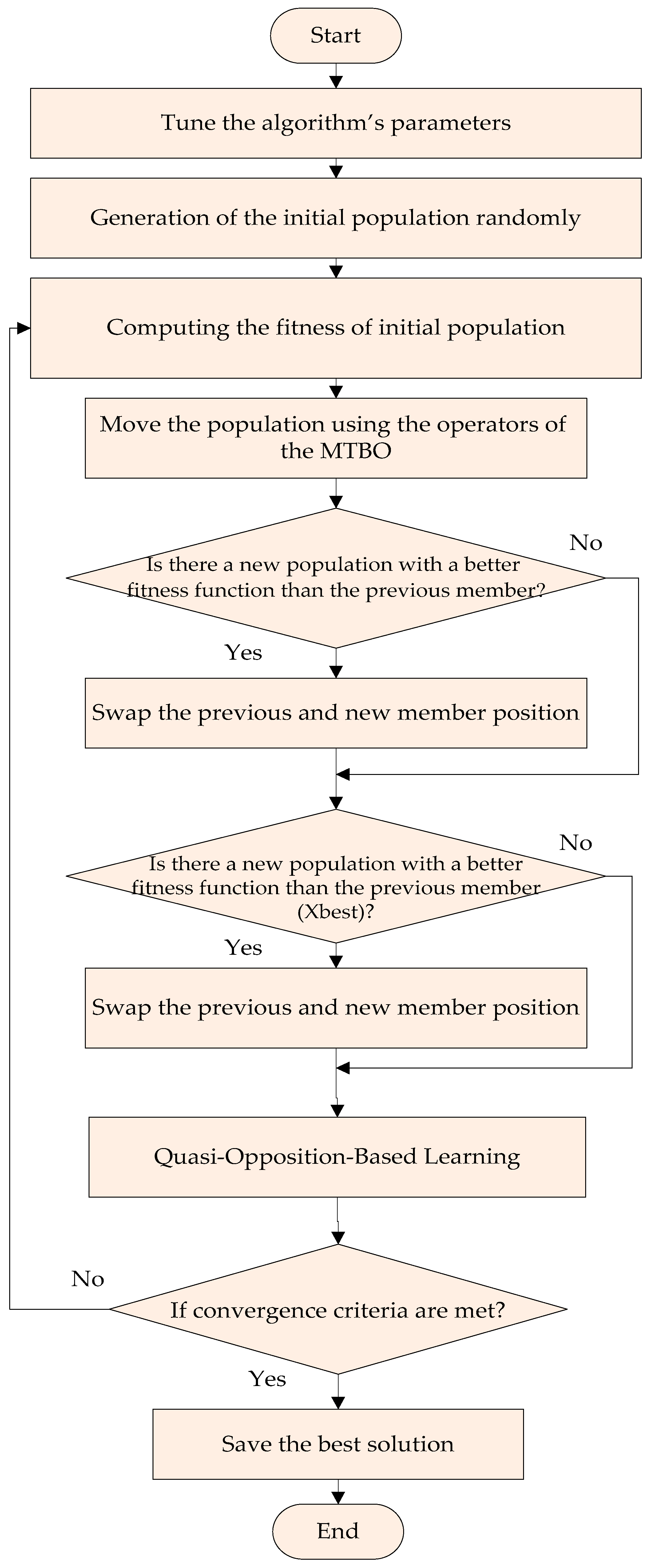
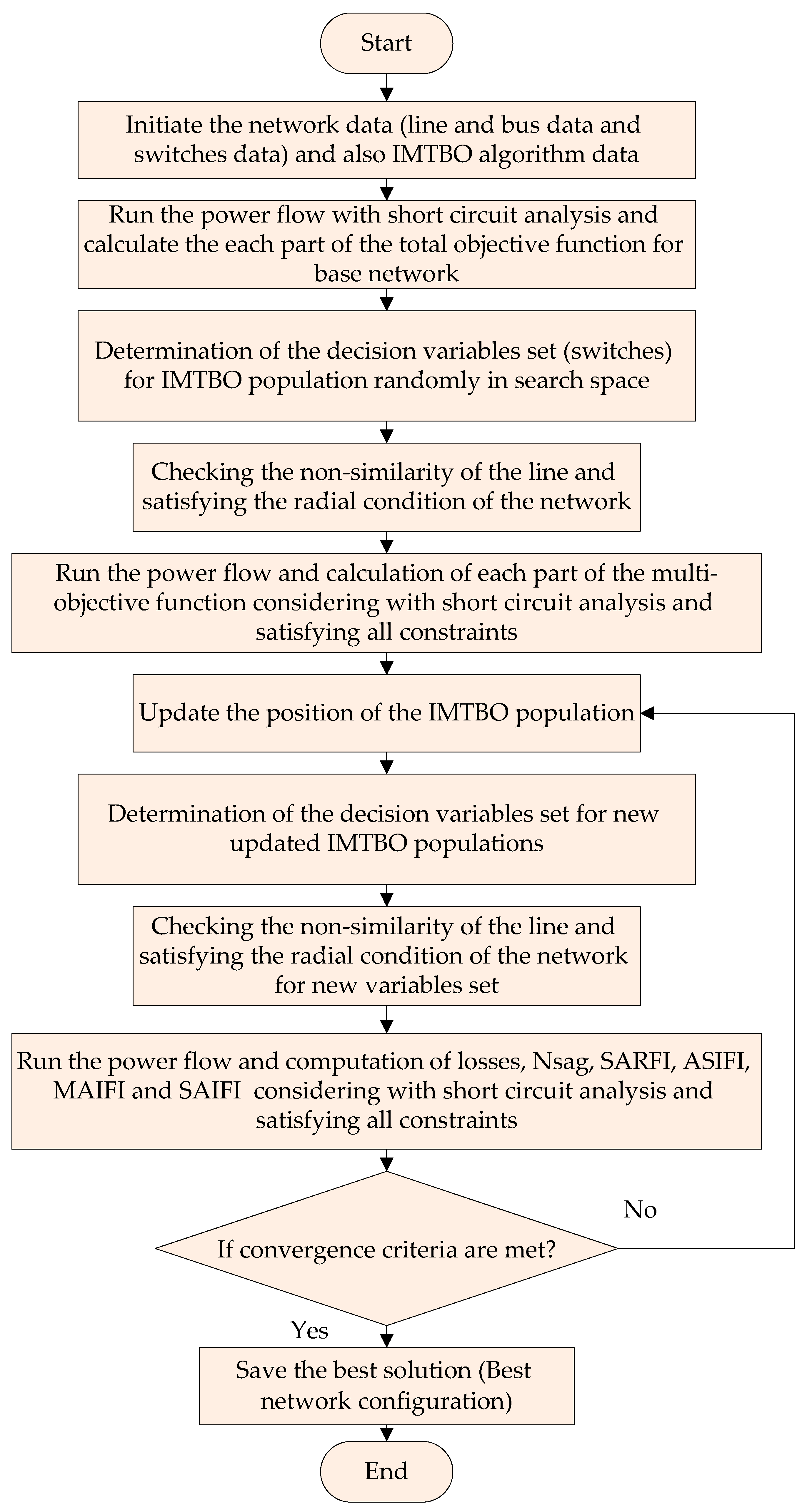
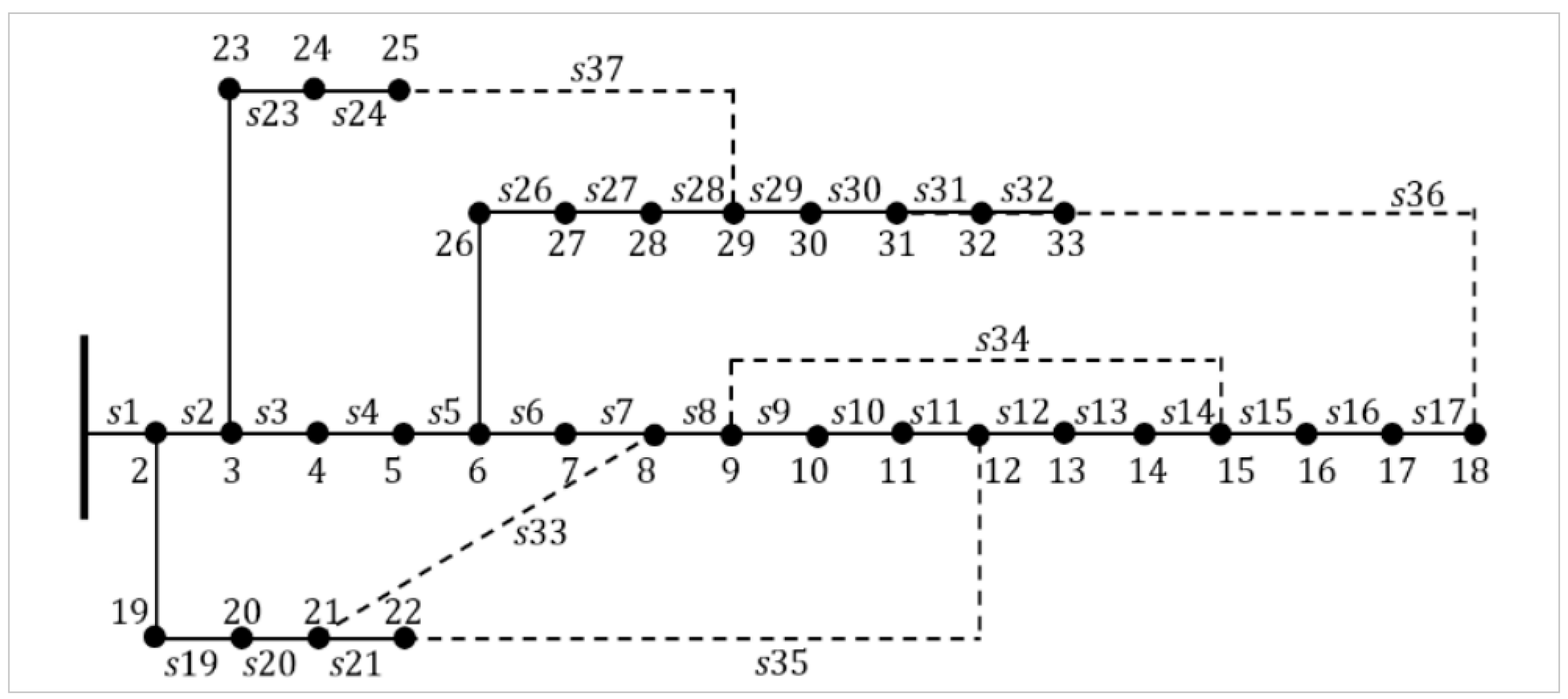
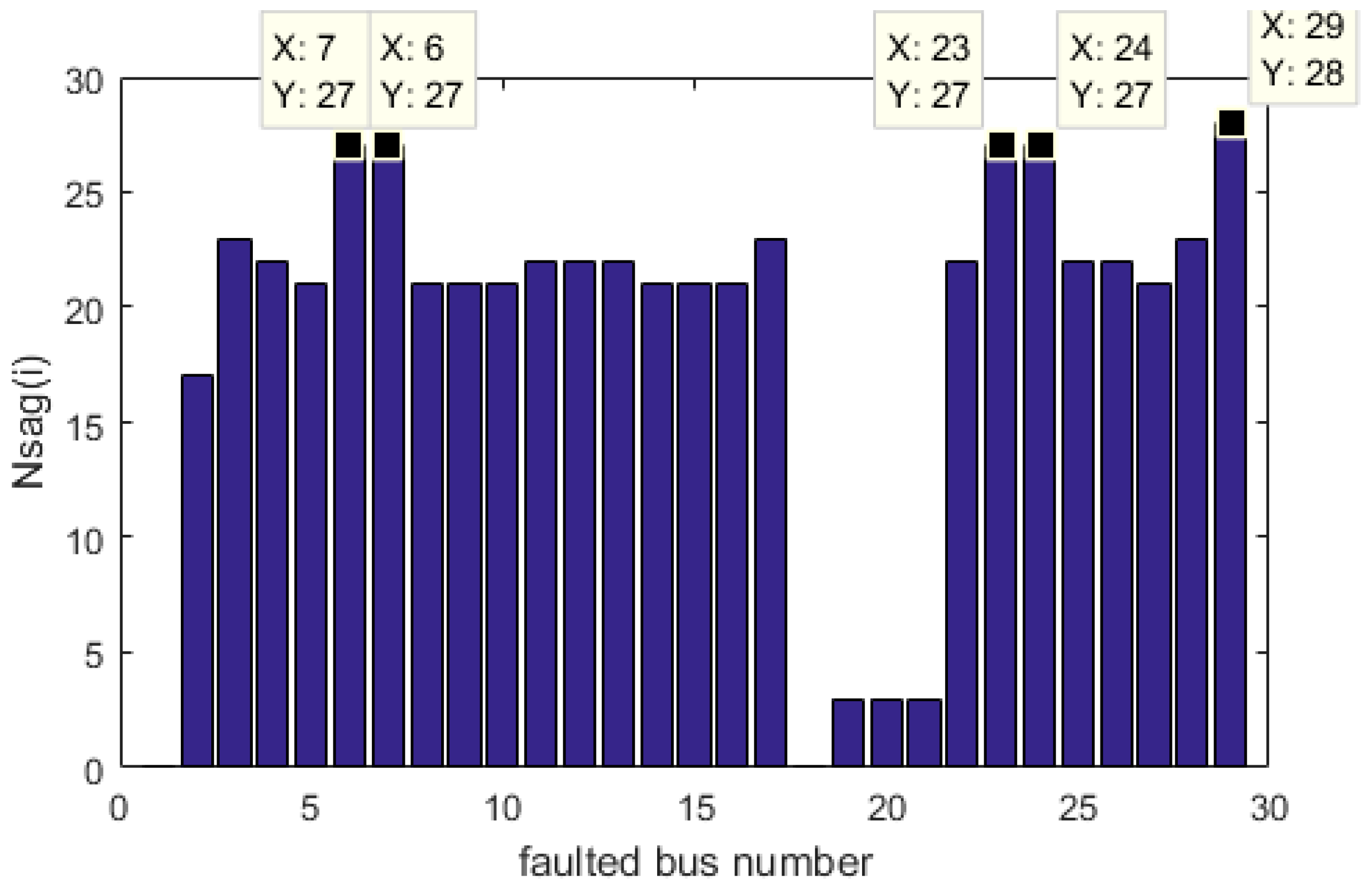
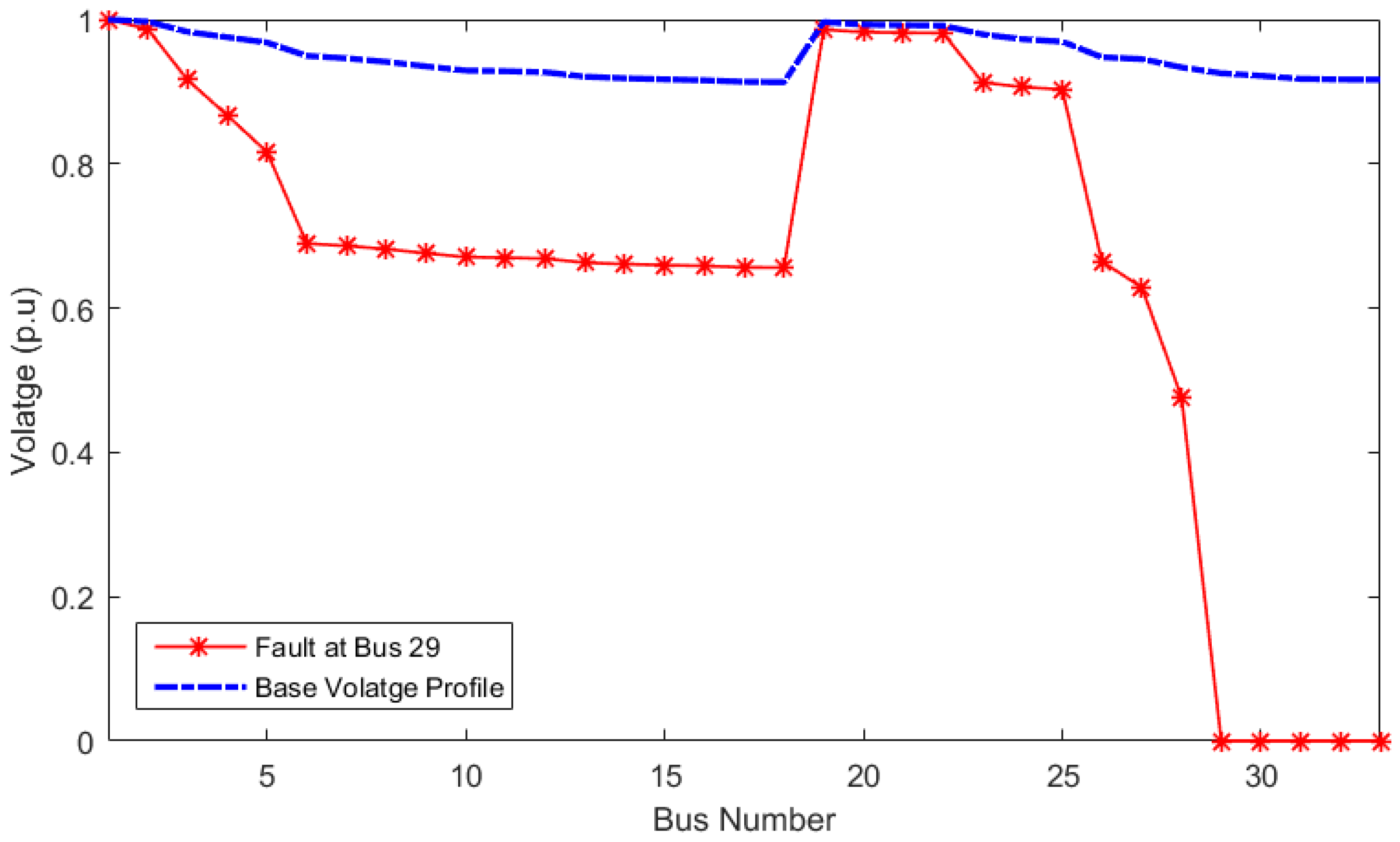
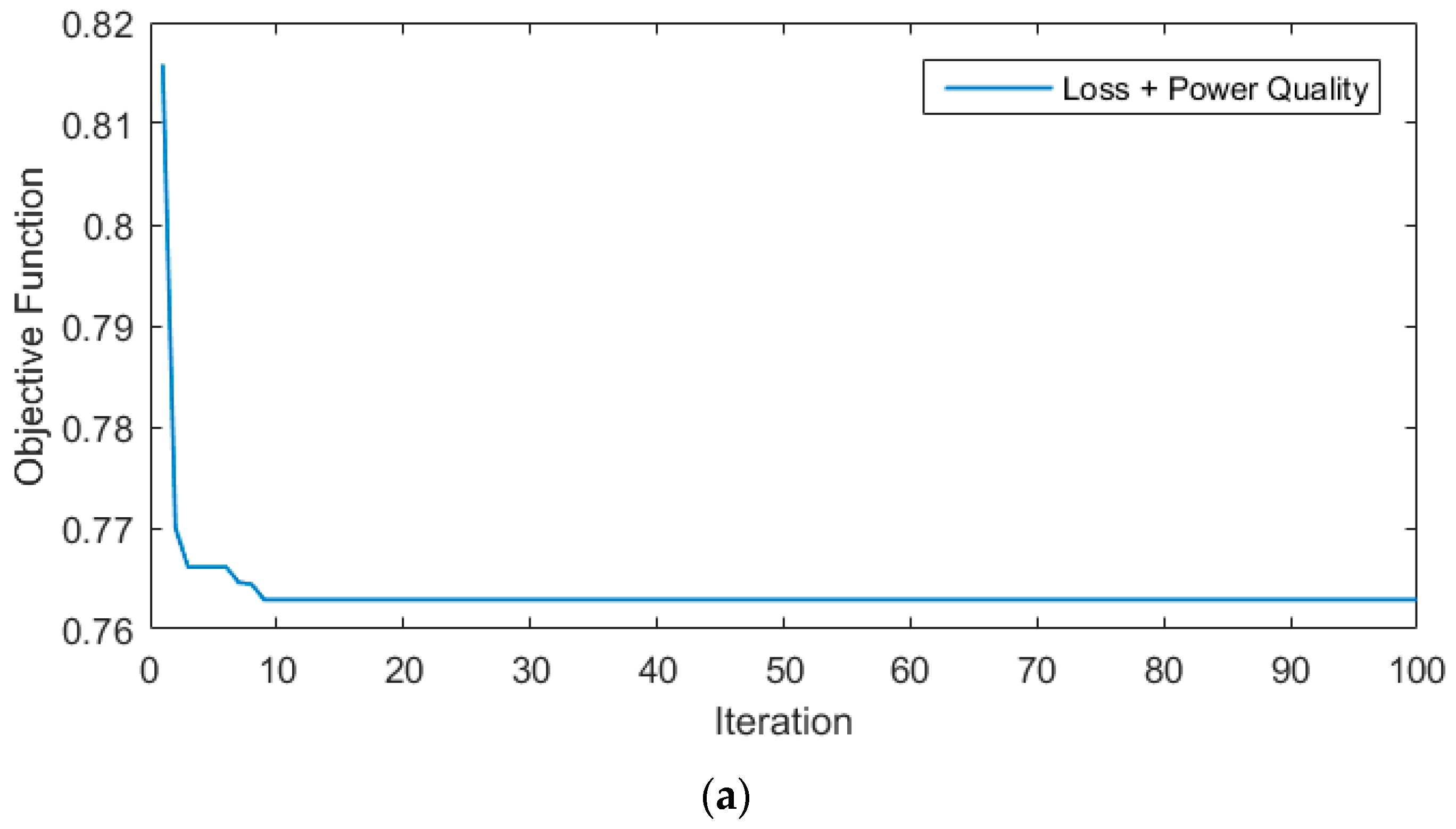
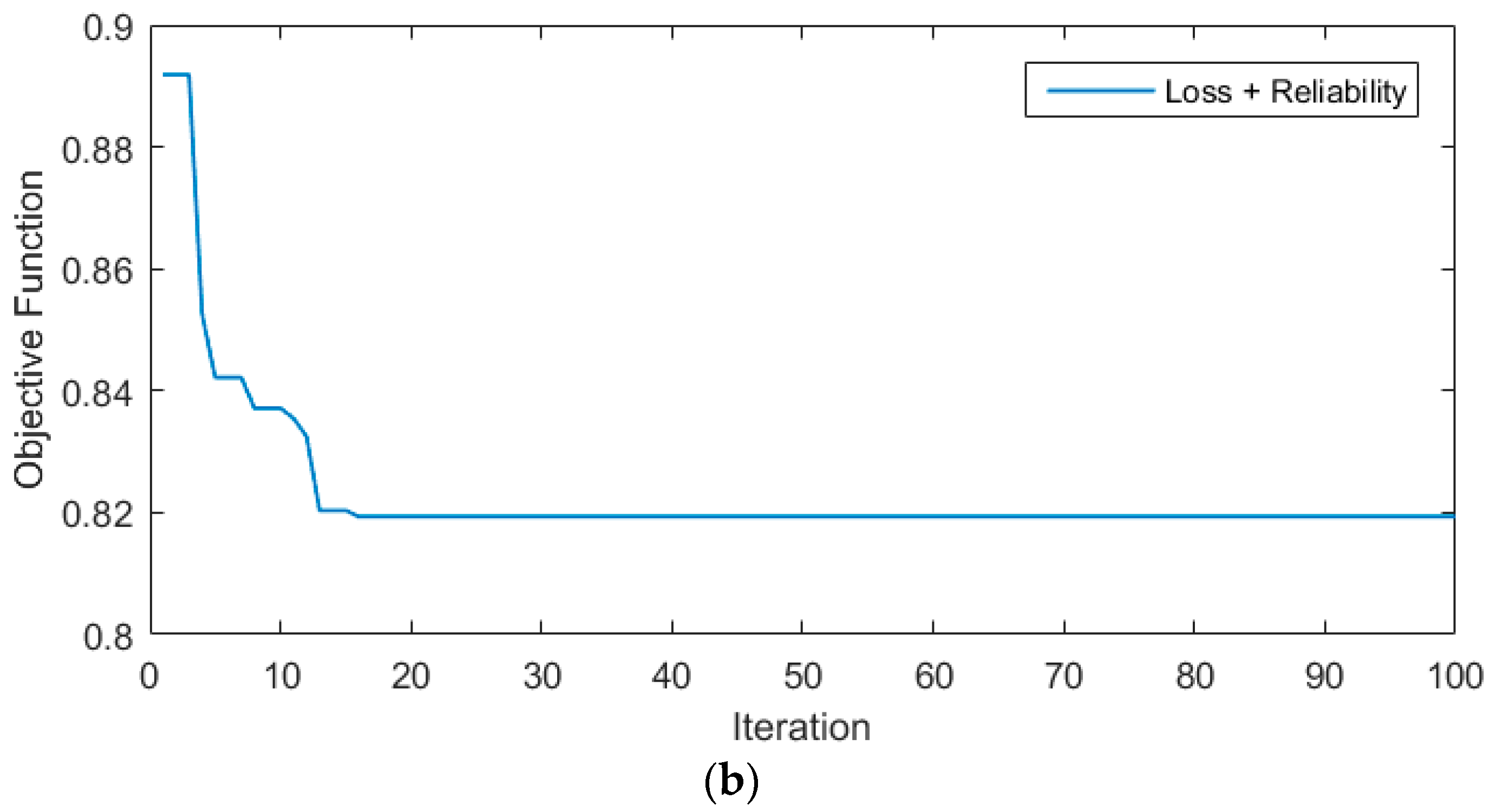
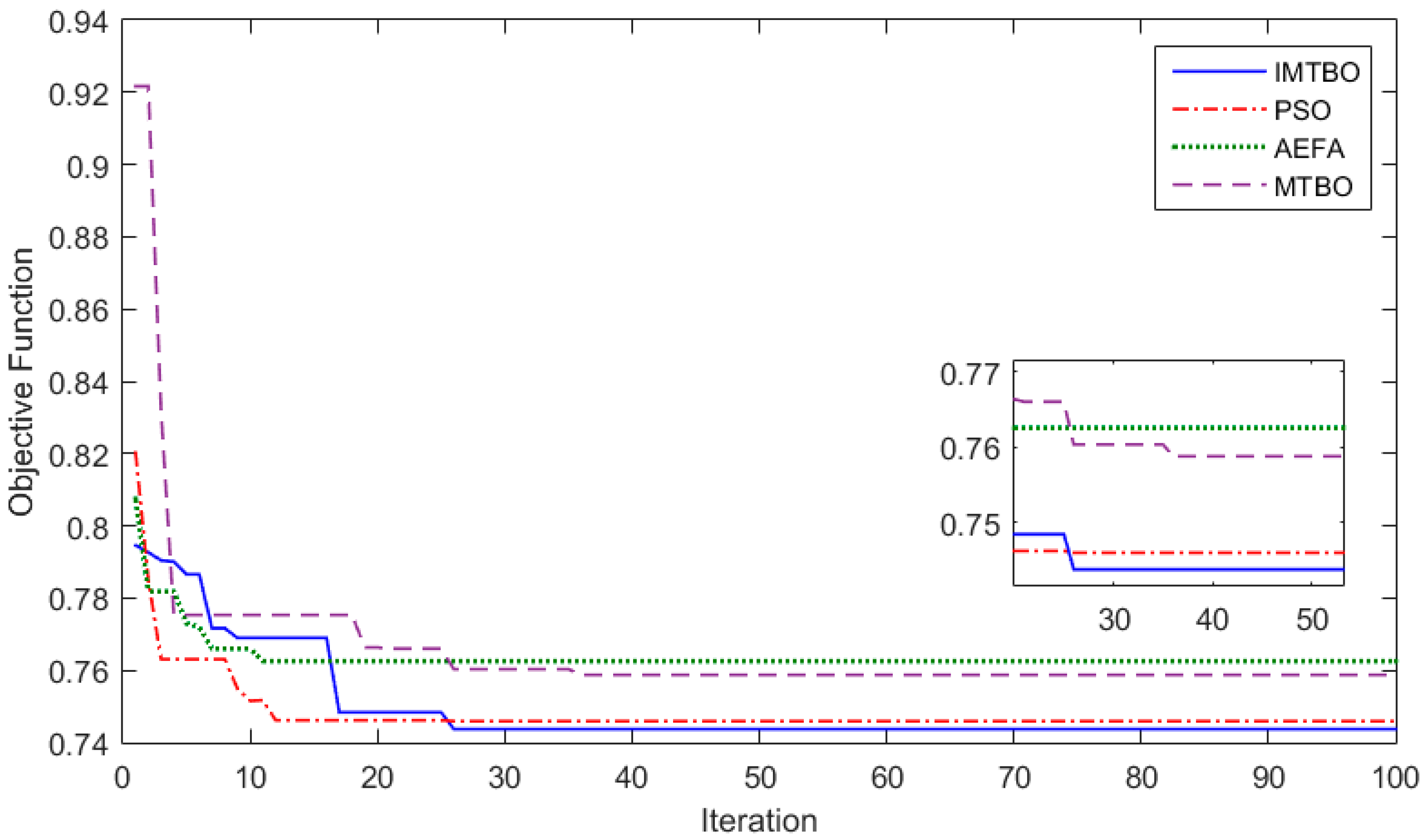
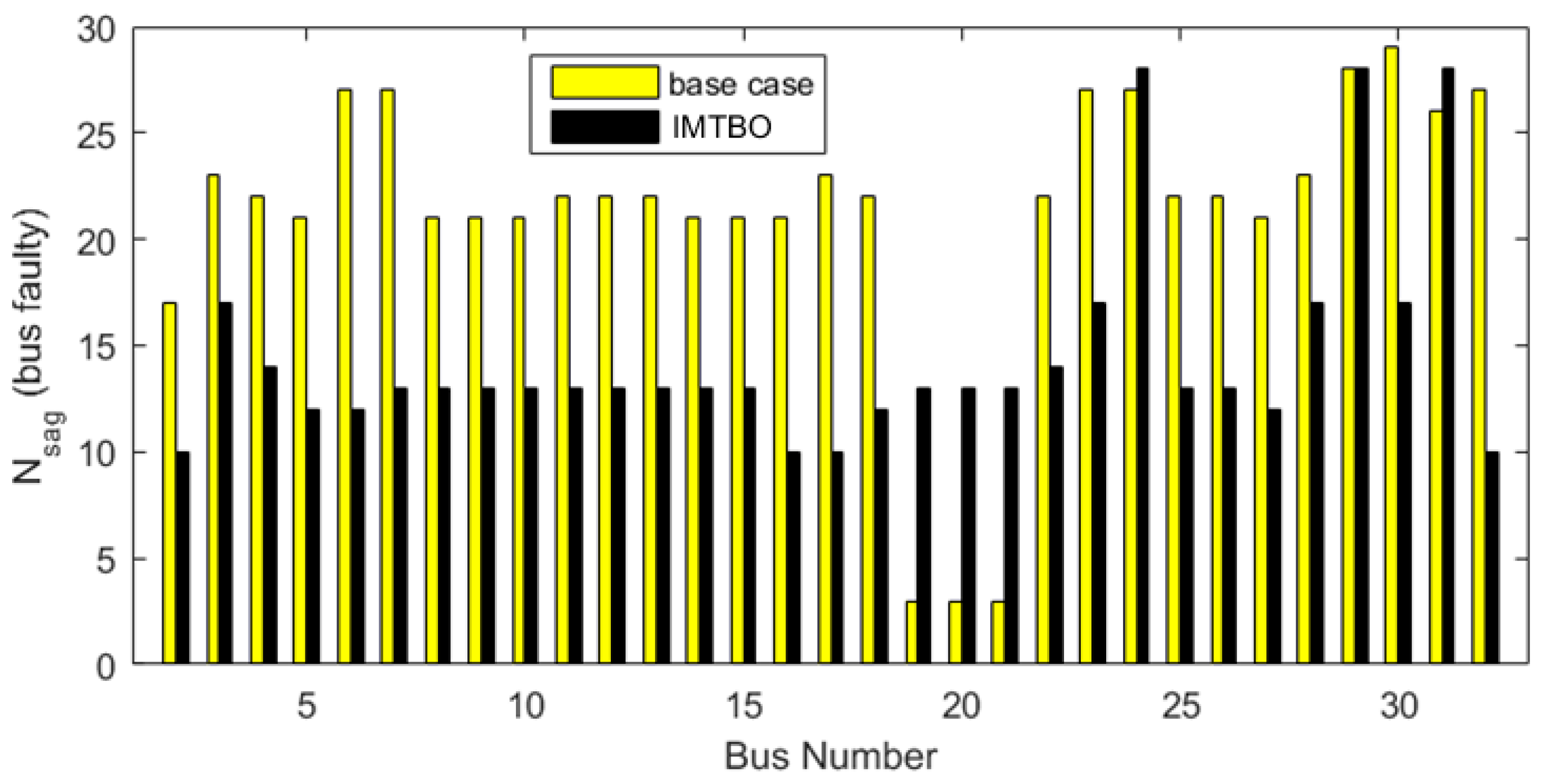
| Algorithm | Parameter |
|---|---|
| MTBO | -- |
| PSO [32] | C1 = C2 = 2 and W: Linear decline from 0.9 to 0.1 |
| AEFA [33,34] | Initial value used in Coulomb’s constant (K0) = 100 |
| Item | Base Network |
|---|---|
| Opened Switches | 33, 34, 35, 36, 37 |
| (kW) | 202.68 |
| 16,104 | |
| 8.2331 | |
| 2.3508 | |
| 4.6479 | |
| 1.3614 | |
| 1 |
| Item/Method | Base Network | Loss + Power Quality (Case 2) | Loss + Reliability (Case 3) |
|---|---|---|---|
| Opened Switches | 33, 34, 35, 36, 37 | 7, 9, 14, 28, 32 | 7, 8, 9, 16, 28 |
| (kW) | 202.68 | 149.9782 | 153.5122 |
| 16,104 | 10,680 | 11,016 | |
| 8.23 | 5.46 | 5.63 | |
| 2.35 | 2.33 | 2.11 | |
| 4.64 | 3.95 | 2.98 | |
| 1.36 | 1.36 | 1.33 | |
| 1 | 0.7629 | 0.81934 |
| Item/Method | Base Network | IMTBO | PSO | AEFA | MTBO |
|---|---|---|---|---|---|
| Opened Switches | 33, 34, 35, 36, 37 | 7, 9, 14, 28, 32 | 7, 10, 14, 28, 32 | 7, 9, 14, 17, 28 | 9, 28, 32, 33, 34 |
| (kW) | 202.68 | 139.97 | 166.94 | 146.28 | 144.77 |
| 16,104 | 10,680 | 11,520 | 10,848 | 10,848 | |
| 8.23 | 5.46 | 5.88 | 5.54 | 5.54 | |
| 2.35 | 2.19 | 2.35 | 2.19 | 2.16 | |
| 4.64 | 2.57 | 2.99 | 2.95 | 2.81 | |
| 1.36 | 1.35 | 1.36 | 1.39 | 1.37 | |
| 1 | 0.74372 | 0.74594 | 0.76256 | 0.75876 | |
| - | 142.36 | 144.11 | 148.57 | 150.68 |
| Item/Method | IMTBO | MFO [47] | EGA [48] | SSA [49] | BWOA [50] |
|---|---|---|---|---|---|
| Opened Switches | 7, 9, 14, 28, 32 | 7, 10, 14, 28, 36 | 10, 13, 16, 28, 33 | 7, 14, 30, 35, 37 | 7, 9, 14, 28, 32 |
| (kW) | 139.97 | 142.42 | 164.41 | 115.73 | 139.98 |
| 1.35 | -- | 2.158 | 2.2716 | -- |
| Objective Function | Lines | (kW) | SARFI | ASIFI | MAIFI | SAIFI | |
|---|---|---|---|---|---|---|---|
| Base network (Case 1) | 33, 34, 35, 36, 37 | 16,104 | 202.68 | 8.23 | 2.35 | 4.64 | 1.36 |
| 6, 9, 14, 16, 28 | 10,512 | 154.81 | 5.39 | 2.20 | 2.96 | 1.06 | |
| 7, 9, 14, 17, 28 | 10,848 | 139.95 | 5.54 | 2.09 | 2.95 | 1.39 | |
| 6, 10, 15, 27, 34 | 10,760 | 163.63 | 5.37 | 2.20 | 2.99 | 1.35 | |
| 10, 13, 16, 28, 33 | 12,696 | 161.58 | 6.49 | 1.99 | 3.01 | 1.08 | |
| 6, 10, 13, 26, 31 | 11,832 | 174.14 | 6.04 | 2.52 | 2.56 | 1.06 | |
| 6, 9, 14, 17, 24 | 11,208 | 184.60 | 5.73 | 2.50 | 3.23 | 1.05 | |
| Case 2 | 7, 9, 14, 28, 32 | 10,680 | 149.97 | 5.48 | 2.33 | 3.95 | 1.36 |
| Case 3 | 7, 8, 9, 16, 28 | 11,016 | 153.51 | 5.63 | 2.11 | 2.98 | 1.33 |
| Case 4 | 7, 9, 14, 28, 32 | 10,680 | 139.97 | 5.46 | 2.19 | 2.57 | 1.35 |
| Case | Lines | SARFI | ASIFI | MAIFI | SAIFI | ||
|---|---|---|---|---|---|---|---|
| Deterministic (Without uncertainty, Case 4) | 7, 9, 14, 28, 32 | 10,680 | 139.97 | 5.46 | 2.19 | 2.57 | 1.35 |
| Stochastic (With uncertainty, Case 5) | 7, 10, 28, 32, 34 | 11,256 5.39 | 150.64 7.62 | 5.75 5.31 | 2.24 2.28 | 2.74 6.61 | 1.37 1.48 |
Disclaimer/Publisher’s Note: The statements, opinions and data contained in all publications are solely those of the individual author(s) and contributor(s) and not of MDPI and/or the editor(s). MDPI and/or the editor(s) disclaim responsibility for any injury to people or property resulting from any ideas, methods, instructions or products referred to in the content. |
© 2023 by the authors. Licensee MDPI, Basel, Switzerland. This article is an open access article distributed under the terms and conditions of the Creative Commons Attribution (CC BY) license (https://creativecommons.org/licenses/by/4.0/).
Share and Cite
Zhu, M.; Arabi Nowdeh, S.; Daskalopulu, A. An Improved Human-Inspired Algorithm for Distribution Network Stochastic Reconfiguration Using a Multi-Objective Intelligent Framework and Unscented Transformation. Mathematics 2023, 11, 3658. https://doi.org/10.3390/math11173658
Zhu M, Arabi Nowdeh S, Daskalopulu A. An Improved Human-Inspired Algorithm for Distribution Network Stochastic Reconfiguration Using a Multi-Objective Intelligent Framework and Unscented Transformation. Mathematics. 2023; 11(17):3658. https://doi.org/10.3390/math11173658
Chicago/Turabian StyleZhu, Min, Saber Arabi Nowdeh, and Aspassia Daskalopulu. 2023. "An Improved Human-Inspired Algorithm for Distribution Network Stochastic Reconfiguration Using a Multi-Objective Intelligent Framework and Unscented Transformation" Mathematics 11, no. 17: 3658. https://doi.org/10.3390/math11173658
APA StyleZhu, M., Arabi Nowdeh, S., & Daskalopulu, A. (2023). An Improved Human-Inspired Algorithm for Distribution Network Stochastic Reconfiguration Using a Multi-Objective Intelligent Framework and Unscented Transformation. Mathematics, 11(17), 3658. https://doi.org/10.3390/math11173658







